WSP Mentors
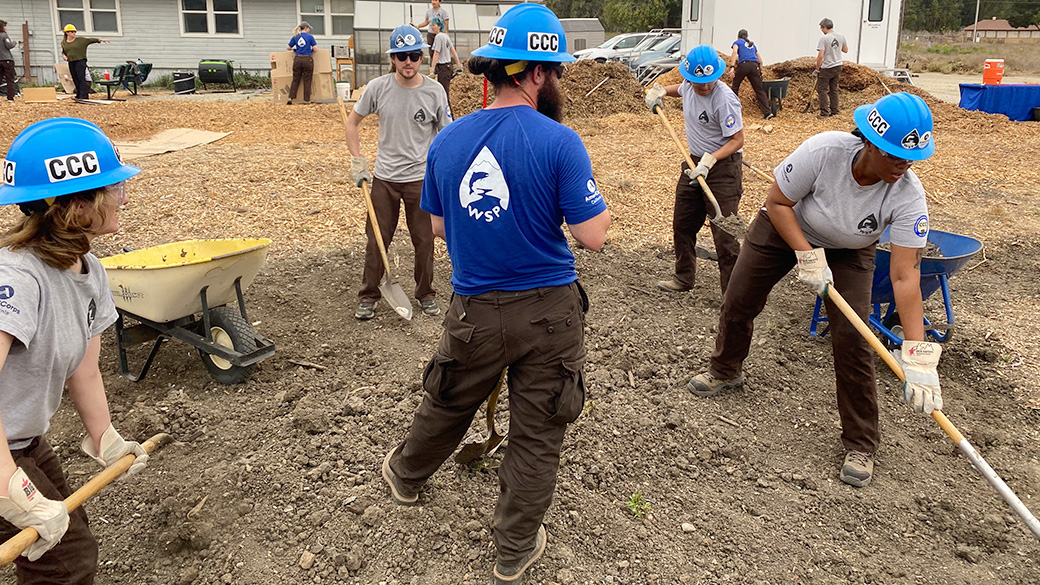
WSP Staff
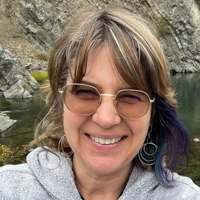
Zia Schatz
Mentor since 2014
What do you find most rewarding about being a Mentor for emerging natural resource professionals?
Corpsmembers who are clarifying their personal and professional life path bring a passion to the workplace that is refreshing and regenerating each new term. Team Leaders are in a unique role, supporting Corpsmembers in the field and taking the time to help each one connect to the overarching WSP mission. Watching Team Leaders engage with students and the public through outreach events, classroom lessons, and field trips is very rewarding. Their diligence and bravery in approaching teaching are amazing to witness.
What is a significant impact that WSP Corpsmembers have had on your organization?
WSP is a special program of the California Conservation Corps and AmeriCorps which is a uniquely run organization with plenty of opportunity for collaboration with staff and professional development. Watching Team Leaders grow in this unique environment gives me endless appreciation for their service and heart. Team Leaders contribute diverse and fresh perspectives on program goals, as well as provide a model of willingness and positive action for our environment.
Program Manager
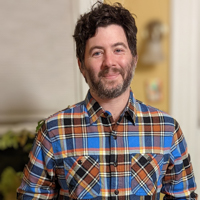
Jason Lopiccolo
Mentor since 2021
What do you find most rewarding about being a Mentor for emerging natural resource professionals?
I’ve had the tremendous fortune to mentor young professionals in the Natural Resources field both as an educator and teaching college lab courses in the biological sciences. Now I oversee WSP as the Program Coordinator for Region I and Mentor to the two WSP Eureka Team Leaders. The most rewarding part of this is helping mentees find out what they’re passionate about and connecting them to the resources they need to realize their professional goals in a meaningful and fulfilling way.
What is a significant impact that WSP Corpsmembers have had on your organization?
As a professional development program for Corpsmembers are at the “core” of what we do. WSP staff can offer a wide breadth of organizational and institutional support for Corpsmembers, but they’re the ones who are out there doing the important, boots-on-the-ground work that makes WSP such a success. The Team Leaders placed at WSP offices act as important liaisons for WSP staff and other Corpsmembers and help to make WSP run smoothly.
Region 1 Program Coordinator
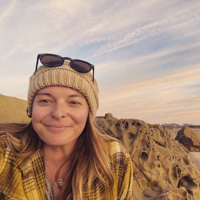
Jody Weseman
Mentor since 2011
What do you find most rewarding about being a Mentor for emerging natural resource professionals?
I enjoy helping young leaders develop their professional voices and increase their capacity as resourceful community activists. I have the honor to work with driven, passionate, and articulate individuals who inspire me to grow further each year. I embrace my opportunity to provide WSP Corpsmembers with a platform to educate Californians about our fragile ecosystems and provide meaningful outlets to truly address climate change.
What is a significant impact that WSP Corpsmembers have had on your organization?
As a WSP staff member/Mentor since 2011, I can say with certainty that WSP Corpsmembers drive WSP, and Team Leaders assist staff in steering! It is reinvigorating to onboard new Corpsmembers each year and feed off the optimistic/motivated energy of our younger generations. Together we create a wonderful community of environmental stewards.
Region 2 Program Coordinator

Madeleine Roberts
What do you find most rewarding about being a WSP staff?
It’s an incredibly impactful program for both Corpsmembers and the communities we engage with. There is a diverse array of opportunities to choose from, catering to the unique interests and needs of young adults from all backgrounds. As part of the team, I take pride in contributing to this larger mission by supporting the various programs and opportunities available to our Corpsmembers. While my role may not involve direct mentoring, I get to witness the positive outcomes of our collective efforts. Knowing that our work contributes to a more vibrant and resilient California that enhances the quality of life for surrounding communities, is truly gratifying!
Office Manager
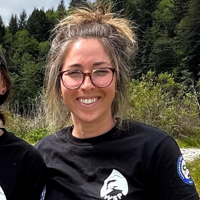
Alison Cordera
What do you find most rewarding about being a WSP staff?
Although I have only been with the Watersheds Stewards Program for a few months now, it has been tremendously rewarding so far. When I first started with the program, it was mainly being able to contribute to the restoration of our local watersheds and fisheries. But as I meet and interact more with the Corpsmembers, Team Leaders, Mentors, and other WSP members, it has become even more rewarding getting to know them and building a sense of community with like-minded people. At the end of the day, I know that our program is having a positive impact on our environment and our communities.
Materials Manager
WSP Mentors
Region 1 – Districts A and B
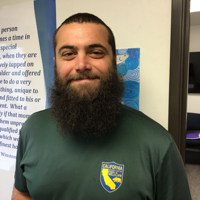
Domenic Guidice
Mentor since 2018
What do you find most rewarding about being a Mentor for emerging natural resource professionals?
As a Mentor, I enjoy introducing new members to the joys and challenges of fisheries work. I enjoy seeing new members develop an appreciation for our natural resources.
What is a significant impact that WSP Corpsmembers have had on your organization?
WSP Corpsmembers help to complete several field projects while completing individual assignments as well. These individual assignments help create and maintain important working relationships with the local community.
California Department of Fish and Wildlife, Yreka
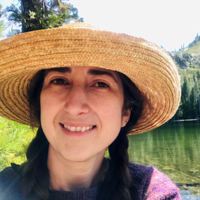
Rosemary Romero (she/her/hers)
Mentor since 2023
What do you find most rewarding about being a Mentor for emerging natural resource professionals?
Learning about each Corpsmember’s career goals and ensuring they are getting the most out of their experience at our site, so they are prepared for the next step in their career as Environmental Professionals.
What is a significant impact that WSP Corpsmembers have had on your organization?
WSP Corpsmembers contribute to long-term fisheries datasets which are valuable to local communities, the state of California, tribal governments & organizations, neighboring states, and federal government agencies throughout the Klamath Basin. They enhance our ability to maintain these datasets while bringing and sharing enthusiastic energy and diverse perspectives on the work we are doing.
California Department of Fish and Wildlife, Yreka
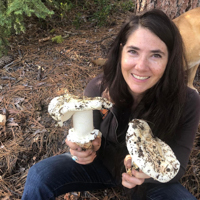
Crystal Robinson
AmeriCorps member 2001-2003; Mentor since 2022
What do you find most rewarding about being a Mentor for emerging natural resource professionals?
It is exciting to introduce young professionals to the field of biology. They offer new perspectives outside the usual box we all have been working in for decades.
What is a significant impact that WSP Corpsmembers have had on your organization?
WSP has brought educated scientists to our remote part of the world where it is often hard to find qualified individuals. Many of them have stayed on to work in the Klamath basin and their experience with fieldwork, as well as outreach and education, is a real asset to the natural resources.
California Department of Fish and Wildlife, Yreka
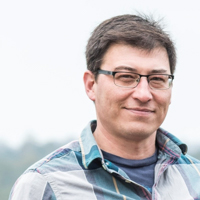
Josh Cahill (he/him/his)
WSP mentor since 2022
What do you find most rewarding about being a Mentor for emerging natural resources professionals?
While it is rewarding to see the excitement and astonishment on new Corpsmembers’ faces when taking them into seldom-trodden work sites, the most fulfilling aspect of being a Mentor is exposing enthusiastic, budding professionals to the cultural significance and community impact of natural resource management. It is also gratifying to share my knowledge and experience with someone building their career path.
Share a significant impact that WSP Corpsmembers have had on your organization?
Having WSP has allowed us to split into more crews and complete more fieldwork. Training new WSP corpsmembers has also reinforced Yurok Environmental staff in our individual areas of professional expertise.
Yurok Tribe Environmental Department

Colin Anderson
Environmental Scientist
WSP Alumnus, Years 3 & 4
Mentor since 2015 (Working with Corpsmembers since 2000)
What do you find most rewarding about being a Mentor for emerging natural resource professionals?
Seeing the growth in Corpsmembers is very rewarding. They come in wide-eyed and open to experience, then learn about working with fish and working as a team. We have a really amazing team here – really they are all Mentors.
What is a significant impact that WSP Corpsmembers have had on your organization?
Having Corpsmembers at our site helps us stay fresh – by training someone who has never done this work before, Corpsmembers bring something new to the team and help us keep it real. I am constantly learning from them, and they help keep it exciting and fun. They also help remind us of our connection to the community, through the Watershed Awareness Volunteer Event. Without WSP, sometimes that connection gets lost, because we are so focused on the work we are doing here.
California Department of Fish and Wildlife, Arcata

John Deibner-Hanson
What do you find most rewarding about being a Mentor for emerging natural resources professionals?
It is very difficult to choose just one thing. The most rewarding components of mentorship inevitably come down to a tie between contributing to ecological serial reciprocities by taking what my mentors (WSP and otherwise) of the past gave me, molding and adapting it into something new and useful, passing it on to new members, and watching them take it, change it and keep pushing forward—and all of the leftover ice cream after WAVE events.
Share a significant impact that WSP Corpsmembers have had on your organization?
Without Watershed Stewards gracing us with their efforts each year, I’m afraid we—as an office, an agency, and as fellow stewards of our watersheds—would become what I fear most: Slowly aging humans growing further out of touch with the generations that will inevitably fill our shoes, and thus, with the best paths towards recoveries of many marvelous fish species. WSP Corpsmembers add an indispensable fresh and youthful perspective to our work as fish biologists and ecologists.
California Department of Fish and Wildlife, Arcata
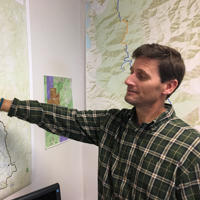
Seth Ricker
Senior Environmental Scientist (Specialist)
Site Supervisor since 2000
What do you find most rewarding about being a Mentor for emerging natural resource professionals?
The best, most satisfying Corpsmembers are the ones who make the most growth during their time with us. They come in unprepared – for the job, the responsibilities – and they come out the other end being prepared for the real world. Our Site has a pretty good record – most of our Members have stayed in the industry.
What is a significant impact that WSP Corpsmembers have had on your organization?
I appreciate WSP for a totally pragmatic reason: WSP Corpsmembers vastly increase the capacity for us to do the science we do here and look at it with fresh eyes.
California Department of Fish and Wildlife, Arcata
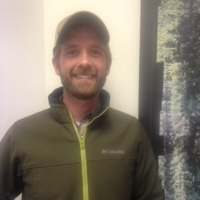
Zane Ruddy
Fish Biologist
Mentor since 2015
What do you find most rewarding about being a Mentor for emerging natural resource professionals?
I enjoy helping them build the bridge towards a long-term career, and helping them build skills that will make them successful.
What is a significant impact that WSP Members have had on your organization?
We are an office of individual specialists – we don’t have a “crew”. By having a WSP Member, it is an automatic way for us to double the effort we are putting toward a project. All of a sudden, twice as much can get done!
Bureau of Land Management, Arcata
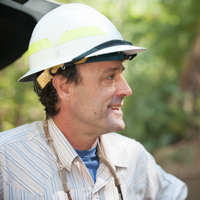
Sam Flanagan
Geologist
Mentor since 2015
What do you find most rewarding about being a Mentor for emerging natural resource professionals?
Sharing time with people who are enthusiastic, motivated, and open to bring new ideas and fresh perspectives.
What is a significant impact that WSP Corpsmembers have had on your organization?
Members improve the quality of work the Site does and are a positive presence.
Bureau of Land Management, Arcata
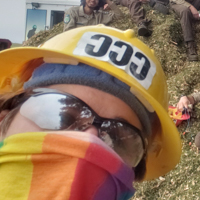
Wren Kaiser (They/Them)
Project Manager
WSP Alumni
What do you find most rewarding about being a Mentor for emerging natural resource professionals?
It’s great to see their enthusiasm for the work they do, professional development, and positive influence on other Corpsmembers.
What is a significant impact that WSP Corpsmembers have had on your organization?
Significant support to salmon restoration project implementation including technical proficiency and ecological/natural resource knowledge that enhances crews’ experiences.
Eel River Watershed Improvement Group, and California Conservation Corps (ECC)

Brian Starks (He/Him)
Fish Habitat Specialist
WSP Alumni
Mentor since 2017
What do you find most rewarding about being a Mentor for emerging natural resource professionals?
The injection of fresh enthusiasm that new Corpsmembers bring every year is invigorating and keeps me on my game. Getting to answer questions about what we do and why we do it always keeps me thinking and helps me learn more about the techniques we use in fisheries restoration. The best ways to learn are to do and to teach, and everyone gets to do both with WSP Corpsmembers at our site!
What is a significant impact that WSP Corpsmembers have had on your organization?
At the Fortuna CCC, we get the pleasure of having our WSP Corpsmembers put on the Creek Days Environmental Education Fair, which would certainly not happen without WSP. This is a great outreach event that reaches hundreds of elementary school students. The CCC doesn’t often get to educate people at such a young age, so to have that opportunity bodes well for the future of conservation. It is also wonderful to have the Corpsmembers working around traditional CCC Corpsmembers. The presence of WSP raises a great deal of interest in the program and gives our CCC Corpsmembers another very tangible career path to aspire to.
Eel River Watershed Improvement Group, and California Conservation Corps (ECC)
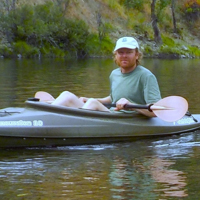
Isaac Mikus
Executive Director of the Eel River Watershed Improvement Group
WSP Mentor since 2017
WSP Alumni Year 11 and 12
What do you find most rewarding about being a Mentor for emerging natural resource professionals?
I feel I have a wonderful opportunity to impart the knowledge that I have accumulated over the last two decades about watershed restoration to an incredible, emerging, young workforce of natural resource professionals. Watching them get excited about restoration invigorates my passion for my job.
What is a significant impact that WSP Corpsmembers have had on your organization?
The WSP Corpsmembers who have worked with us have enhanced our restoration impact in enumerable ways. Their overall knowledge and ability to quickly learn technical skills, associated with conducting the groundwork for multiple projects, is priceless in allowing us to complete bigger and better restoration projects. WSP Corpsmembers have also planned and executed our “Creek Days” annual event, which inspires future generations with the love of the natural environment and the science of watershed ecology. We couldn’t do it without them.
Eel River Watershed Improvement Group, and California Conservation Corps (ECC)
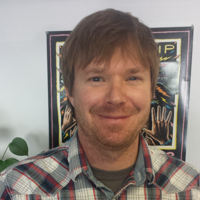
David Kajtaniak
Environmental Scientist
WSP Alumni
Mentor since 2009
What do you find most rewarding about being a Mentor for emerging natural resource professionals?
I certainly enjoy their excitement and enthusiasm for their field of interest. I also enjoy being able to share and pass along my knowledge and skill set to help further advance their careers.
What is a significant impact that WSP Corpsmembers have had on your organization?
Our WSP Corpsmembers have greatly helped spread a positive message and image of our Department to members of the public and other resource agencies and non-profits. Through our field surveys, they also provide a significant portion of the data sets that go into the monitoring and research for our programs.
Department of Fish and Wildlife, Coastal Watershed Planning and Assessment Program

Kaydee Boozel
Environmental Scientist
Mentor since 2023
What do you find most rewarding about being a Mentor for emerging natural resource professionals?
The most rewarding part is getting to work with and teach new Corpsmembers about fisheries science. It is always a fun and enlightening experience. WSP Corpsmembers generally bring great questions, attitudes, and perspectives into the field and I get to learn from them as well.
What is a significant impact that WSP Corpsmembers have had on your organization?
WSP Corpsmembers play a pivotal role in the monitoring programs run through the CWPAP office. Day in and day out they are helping our programs thrive. Whether that is collecting data in the field, entering data, or any other tasks that go into monitoring stream systems, they are there to lend a hand.
Department of Fish and Wildlife, Coastal Watershed Planning and Assessment Program
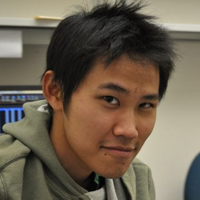
Lance Le
Water Resource Control Engineer
Mentor since 2017
What do you find most rewarding about being a Mentor for emerging natural resource professionals?
Much of my work is desktop and computer-based, and I enjoy exposing WSP Corpsmembers to computer programming and complex data or GIS analysis. This work requires a lot of problem-solving, introspection, and investigative independence, so seeing Corpsmembers exercise these parts of their minds is a most rewarding experience. Nature is beautiful and learning the abstract and mathematical representations we use to understand nature is its reward and also essential for future careers; helping Corpsmembers with this journey is the best part of being a Mentor for me.
What is a significant impact that WSP Corpsmembers have had on your organization?
WSP Corpsmembers provide much-needed support to orphan projects that have too few staff working on them or require learning new skills that can be a significant time investment. Beyond their Placement Site work, having Corpsmembers just be present encourages our staff to interact across programs/units and out of their silos.
North Coast Regional Water Quality Control Board
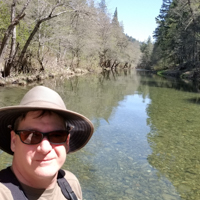
Bryan McFadin
Flow and Riparian Protection Specialist
Mentor since 2016
What do you find most rewarding about being a Mentor for emerging natural resource professionals?
For me, the most rewarding thing about being a Mentor is working with smart, enthusiastic young professionals. I love the energy WSP Corpsmembers bring to their work, which is inspiring.
What is a significant impact that WSP Corpsmembers have had on your organization?
WSP Corpsmembers have allowed us to do more flow and water quality monitoring than we ever could have accomplished without them.
North Coast Regional Water Quality Control Board
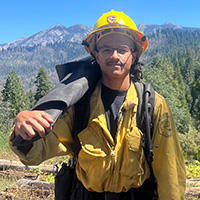
Anna Caro
California State Polytechnic University, Humboldt. B.S. Biology, Emphasis: Marine Biology
Anna was born and raised in a small town outside of Redding, CA. From a young age, she was an avid watcher of Animal Planet on TV and was always keen to learn more about her environmental surroundings. Determined to be the first college graduate in her family, she found her way to Humboldt University studying Marine Biology and working as a laboratory technician at the Telonicher Marine Lab in Trinidad, CA. As an undergrad, she served as part of the first cohort ever for College Corps, another AmeriCorps program aimed at getting students involved with community work, and was how she initially heard about the WSP program. She was drawn in by the combination of educational and community outreach involved, having previous environmental educator experience from working with various land trusts and interpretation in the Redwood National Park. She loves sharing her knowledge with others and is most excited for hands-on fieldwork with CDFW where she will be able to learn more about her local watersheds from highly experienced professionals. Outside of work, Anna considers herself a self-taught naturalist. She enjoys backroad botanizing, tide pooling for nudibranchs, and working on her photography. She is always looking for a new hike or backpacking trip to challenge herself and more ecosystems to explore.
North Coast Regional Water Quality Control Board

Edgar Cruz
University of California Santa Cruz, B.A. Environmental Studies, Emphasis: Natural History, Land Stewardship, Agroecology and Sustainable Food Systems; B.A. Art, Emphasis: Photography and Photo-based Printmaking; 2nd Year Corpsmember
Edgar is an ecologist, land steward, and artist who was born and raised in South Central Los Angeles (unceded Tongva land) and descends from the Sierra Norte of Oaxaca (Cajonos Zapoteco). He is currently serving his second year with the Watershed Stewards Program (WSP) due to its focus on watershed improvement and recovery through community education, land stewardship, and hands-on field research. In his first WSP term at CDFW Big Sur, he helped monitor federally threatened Steelhead along the Big Sur coastline. As a second-year Corpsmember at CDFW Arcata, Edgar is honored to be working alongside Coho, Chinook, Steelhead, Cutthroat, and Lamprey in various watersheds throughout California’s North Coast. In addition to his ecological work, Edgar is a visual artist whose artwork examines his relationship to land, space, and environment. Often utilizing organic materials such as plants, sunlight, and water, his monochromatic photographic prints create narratives of intimacy and connection. He has participated in various group exhibitions in Los Angeles and Santa Cruz. Involved in both the art and environmental conservation realms, Edgar hopes to find a profession that bridges his passions and knowledge of art, ecology, and land stewardship.
North Coast Regional Water Quality Control Board
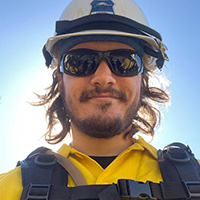
Hunter Perez
California State Polytechnic University, Humboldt, B.S. Wildlife Biology, Emphasis: Conservation and Management
Hunter is from Oceanside, California in San Diego County. During his undergrad, Hunter volunteered at the Humboldt Wildlife Care Center rehabilitating injured wildlife in the Humboldt area. Post-graduation, he worked as a scientific aid for CDFW for two years and then worked in the private sector as a fisheries biologist doing salmonid habitat typing in creeks throughout Northern California. Hunter chose WSP after having served as a scientific aid through CDFW for two years. One season in the Marine region, and another season in the Freshwater region. While working in the freshwater region at CDFW Arcata, He met two WSP Corpsmembers (Kat and Tiffany) who were placed there and told him about the program and inspired him to join. WSP provides so many unique opportunities from hands-on work with salmonids to habitat conservation, and even public outreach/education. Having graduated with a background in Wildlife and focusing primarily on terrestrial vertebrates, WSP provides great opportunities for those who are looking to start a career in Fisheries and watershed-related fields. Hunter is most looking forward to helping with integrating genetics from wild Steelhead trout into the Mad River’s Hatchery genetic pool, assuring populations are genetically fit for future generations. In his free time, Hunter loves to skateboard and has been skating for 18 years.
Point Reyes National Seashore
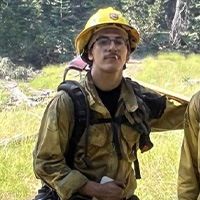
Veronica Klenk
Ramapo College of New Jersey, B.S. Environmental Science
Veronica lived in New Jersey for her whole life before moving to Northern California, to follow her dream of working with Pacific Salmon. She chose to serve with WSP because it offers countless opportunities to learn more about salmonids and meet others who are equally passionate about watershed conservation and environmental stewardship. WSP also provides Veronica with the ability to be of service to her new community, and she is eager for the chance to organize and participate in restoration events. At CDFW Arcata, Veronica is excited to get hands-on experience with salmonids in all stages of their fascinating life cycles while exploring the local watershed and getting involved in the various research projects happening in the area. She hopes to continue her lifelong journey of discovery by attending graduate school after completing her WSP term. Veronica loves being outside and spends her free time hiking, camping, mountain biking, and birdwatching!
Point Reyes National Seashore

Anna Caro
California State Polytechnic University, Humboldt. B.S. Biology, Emphasis: Marine Biology
Anna was born and raised in a small town outside of Redding, CA. From a young age, she was an avid watcher of Animal Planet on TV and was always keen to learn more about her environmental surroundings. Determined to be the first college graduate in her family, she found her way to Humboldt University studying Marine Biology and working as a laboratory technician at the Telonicher Marine Lab in Trinidad, CA. As an undergrad, she served as part of the first cohort ever for College Corps, another AmeriCorps program aimed at getting students involved with community work, and was how she initially heard about the WSP program. She was drawn in by the combination of educational and community outreach involved, having previous environmental educator experience from working with various land trusts and interpretation in the Redwood National Park. She loves sharing her knowledge with others and is most excited for hands-on fieldwork with CDFW where she will be able to learn more about her local watersheds from highly experienced professionals. Outside of work, Anna considers herself a self-taught naturalist. She enjoys backroad botanizing, tide pooling for nudibranchs, and working on her photography. She is always looking for a new hike or backpacking trip to challenge herself and more ecosystems to explore.
US Fish and Wildlife Service, Lodi

Edgar Cruz
University of California Santa Cruz, B.A. Environmental Studies, Emphasis: Natural History, Land Stewardship, Agroecology and Sustainable Food Systems; B.A. Art, Emphasis: Photography and Photo-based Printmaking; 2nd Year Corpsmember
Edgar is an ecologist, land steward, and artist who was born and raised in South Central Los Angeles (unceded Tongva land) and descends from the Sierra Norte of Oaxaca (Cajonos Zapoteco). He is currently serving his second year with the Watershed Stewards Program (WSP) due to its focus on watershed improvement and recovery through community education, land stewardship, and hands-on field research. In his first WSP term at CDFW Big Sur, he helped monitor federally threatened Steelhead along the Big Sur coastline. As a second-year Corpsmember at CDFW Arcata, Edgar is honored to be working alongside Coho, Chinook, Steelhead, Cutthroat, and Lamprey in various watersheds throughout California’s North Coast. In addition to his ecological work, Edgar is a visual artist whose artwork examines his relationship to land, space, and environment. Often utilizing organic materials such as plants, sunlight, and water, his monochromatic photographic prints create narratives of intimacy and connection. He has participated in various group exhibitions in Los Angeles and Santa Cruz. Involved in both the art and environmental conservation realms, Edgar hopes to find a profession that bridges his passions and knowledge of art, ecology, and land stewardship.
US Fish and Wildlife Service, Lodi

Hunter Perez
California State Polytechnic University, Humboldt, B.S. Wildlife Biology, Emphasis: Conservation and Management
Hunter is from Oceanside, California in San Diego County. During his undergrad, Hunter volunteered at the Humboldt Wildlife Care Center rehabilitating injured wildlife in the Humboldt area. Post-graduation, he worked as a scientific aid for CDFW for two years and then worked in the private sector as a fisheries biologist doing salmonid habitat typing in creeks throughout Northern California. Hunter chose WSP after having served as a scientific aid through CDFW for two years. One season in the Marine region, and another season in the Freshwater region. While working in the freshwater region at CDFW Arcata, He met two WSP Corpsmembers (Kat and Tiffany) who were placed there and told him about the program and inspired him to join. WSP provides so many unique opportunities from hands-on work with salmonids to habitat conservation, and even public outreach/education. Having graduated with a background in Wildlife and focusing primarily on terrestrial vertebrates, WSP provides great opportunities for those who are looking to start a career in Fisheries and watershed-related fields. Hunter is most looking forward to helping with integrating genetics from wild Steelhead trout into the Mad River’s Hatchery genetic pool, assuring populations are genetically fit for future generations. In his free time, Hunter loves to skateboard and has been skating for 18 years.
US Fish and Wildlife Service, Lodi

Veronica Klenk
Ramapo College of New Jersey, B.S. Environmental Science
Veronica lived in New Jersey for her whole life before moving to Northern California, to follow her dream of working with Pacific Salmon. She chose to serve with WSP because it offers countless opportunities to learn more about salmonids and meet others who are equally passionate about watershed conservation and environmental stewardship. WSP also provides Veronica with the ability to be of service to her new community, and she is eager for the chance to organize and participate in restoration events. At CDFW Arcata, Veronica is excited to get hands-on experience with salmonids in all stages of their fascinating life cycles while exploring the local watershed and getting involved in the various research projects happening in the area. She hopes to continue her lifelong journey of discovery by attending graduate school after completing her WSP term. Veronica loves being outside and spends her free time hiking, camping, mountain biking, and birdwatching!
US Fish and Wildlife Service, Lodi

Anna Caro
California State Polytechnic University, Humboldt. B.S. Biology, Emphasis: Marine Biology
Anna was born and raised in a small town outside of Redding, CA. From a young age, she was an avid watcher of Animal Planet on TV and was always keen to learn more about her environmental surroundings. Determined to be the first college graduate in her family, she found her way to Humboldt University studying Marine Biology and working as a laboratory technician at the Telonicher Marine Lab in Trinidad, CA. As an undergrad, she served as part of the first cohort ever for College Corps, another AmeriCorps program aimed at getting students involved with community work, and was how she initially heard about the WSP program. She was drawn in by the combination of educational and community outreach involved, having previous environmental educator experience from working with various land trusts and interpretation in the Redwood National Park. She loves sharing her knowledge with others and is most excited for hands-on fieldwork with CDFW where she will be able to learn more about her local watersheds from highly experienced professionals. Outside of work, Anna considers herself a self-taught naturalist. She enjoys backroad botanizing, tide pooling for nudibranchs, and working on her photography. She is always looking for a new hike or backpacking trip to challenge herself and more ecosystems to explore.
Marin Municipal Water District Fisheries Program

Edgar Cruz
University of California Santa Cruz, B.A. Environmental Studies, Emphasis: Natural History, Land Stewardship, Agroecology and Sustainable Food Systems; B.A. Art, Emphasis: Photography and Photo-based Printmaking; 2nd Year Corpsmember
Edgar is an ecologist, land steward, and artist who was born and raised in South Central Los Angeles (unceded Tongva land) and descends from the Sierra Norte of Oaxaca (Cajonos Zapoteco). He is currently serving his second year with the Watershed Stewards Program (WSP) due to its focus on watershed improvement and recovery through community education, land stewardship, and hands-on field research. In his first WSP term at CDFW Big Sur, he helped monitor federally threatened Steelhead along the Big Sur coastline. As a second-year Corpsmember at CDFW Arcata, Edgar is honored to be working alongside Coho, Chinook, Steelhead, Cutthroat, and Lamprey in various watersheds throughout California’s North Coast. In addition to his ecological work, Edgar is a visual artist whose artwork examines his relationship to land, space, and environment. Often utilizing organic materials such as plants, sunlight, and water, his monochromatic photographic prints create narratives of intimacy and connection. He has participated in various group exhibitions in Los Angeles and Santa Cruz. Involved in both the art and environmental conservation realms, Edgar hopes to find a profession that bridges his passions and knowledge of art, ecology, and land stewardship.
Marin Municipal Water District Fisheries Program

Hunter Perez
California State Polytechnic University, Humboldt, B.S. Wildlife Biology, Emphasis: Conservation and Management
Hunter is from Oceanside, California in San Diego County. During his undergrad, Hunter volunteered at the Humboldt Wildlife Care Center rehabilitating injured wildlife in the Humboldt area. Post-graduation, he worked as a scientific aid for CDFW for two years and then worked in the private sector as a fisheries biologist doing salmonid habitat typing in creeks throughout Northern California. Hunter chose WSP after having served as a scientific aid through CDFW for two years. One season in the Marine region, and another season in the Freshwater region. While working in the freshwater region at CDFW Arcata, He met two WSP Corpsmembers (Kat and Tiffany) who were placed there and told him about the program and inspired him to join. WSP provides so many unique opportunities from hands-on work with salmonids to habitat conservation, and even public outreach/education. Having graduated with a background in Wildlife and focusing primarily on terrestrial vertebrates, WSP provides great opportunities for those who are looking to start a career in Fisheries and watershed-related fields. Hunter is most looking forward to helping with integrating genetics from wild Steelhead trout into the Mad River’s Hatchery genetic pool, assuring populations are genetically fit for future generations. In his free time, Hunter loves to skateboard and has been skating for 18 years.
Marin Municipal Water District Fisheries Program
Region 2 – Districts C and D

Anna Caro
California State Polytechnic University, Humboldt. B.S. Biology, Emphasis: Marine Biology
Anna was born and raised in a small town outside of Redding, CA. From a young age, she was an avid watcher of Animal Planet on TV and was always keen to learn more about her environmental surroundings. Determined to be the first college graduate in her family, she found her way to Humboldt University studying Marine Biology and working as a laboratory technician at the Telonicher Marine Lab in Trinidad, CA. As an undergrad, she served as part of the first cohort ever for College Corps, another AmeriCorps program aimed at getting students involved with community work, and was how she initially heard about the WSP program. She was drawn in by the combination of educational and community outreach involved, having previous environmental educator experience from working with various land trusts and interpretation in the Redwood National Park. She loves sharing her knowledge with others and is most excited for hands-on fieldwork with CDFW where she will be able to learn more about her local watersheds from highly experienced professionals. Outside of work, Anna considers herself a self-taught naturalist. She enjoys backroad botanizing, tide pooling for nudibranchs, and working on her photography. She is always looking for a new hike or backpacking trip to challenge herself and more ecosystems to explore.
San Francisco Estuary Institute

Edgar Cruz
University of California Santa Cruz, B.A. Environmental Studies, Emphasis: Natural History, Land Stewardship, Agroecology and Sustainable Food Systems; B.A. Art, Emphasis: Photography and Photo-based Printmaking; 2nd Year Corpsmember
Edgar is an ecologist, land steward, and artist who was born and raised in South Central Los Angeles (unceded Tongva land) and descends from the Sierra Norte of Oaxaca (Cajonos Zapoteco). He is currently serving his second year with the Watershed Stewards Program (WSP) due to its focus on watershed improvement and recovery through community education, land stewardship, and hands-on field research. In his first WSP term at CDFW Big Sur, he helped monitor federally threatened Steelhead along the Big Sur coastline. As a second-year Corpsmember at CDFW Arcata, Edgar is honored to be working alongside Coho, Chinook, Steelhead, Cutthroat, and Lamprey in various watersheds throughout California’s North Coast. In addition to his ecological work, Edgar is a visual artist whose artwork examines his relationship to land, space, and environment. Often utilizing organic materials such as plants, sunlight, and water, his monochromatic photographic prints create narratives of intimacy and connection. He has participated in various group exhibitions in Los Angeles and Santa Cruz. Involved in both the art and environmental conservation realms, Edgar hopes to find a profession that bridges his passions and knowledge of art, ecology, and land stewardship.
San Francisco Estuary Institute

Hunter Perez
California State Polytechnic University, Humboldt, B.S. Wildlife Biology, Emphasis: Conservation and Management
Hunter is from Oceanside, California in San Diego County. During his undergrad, Hunter volunteered at the Humboldt Wildlife Care Center rehabilitating injured wildlife in the Humboldt area. Post-graduation, he worked as a scientific aid for CDFW for two years and then worked in the private sector as a fisheries biologist doing salmonid habitat typing in creeks throughout Northern California. Hunter chose WSP after having served as a scientific aid through CDFW for two years. One season in the Marine region, and another season in the Freshwater region. While working in the freshwater region at CDFW Arcata, He met two WSP Corpsmembers (Kat and Tiffany) who were placed there and told him about the program and inspired him to join. WSP provides so many unique opportunities from hands-on work with salmonids to habitat conservation, and even public outreach/education. Having graduated with a background in Wildlife and focusing primarily on terrestrial vertebrates, WSP provides great opportunities for those who are looking to start a career in Fisheries and watershed-related fields. Hunter is most looking forward to helping with integrating genetics from wild Steelhead trout into the Mad River’s Hatchery genetic pool, assuring populations are genetically fit for future generations. In his free time, Hunter loves to skateboard and has been skating for 18 years.
San Francisco Bay Regional Water Quality Control Board

Veronica Klenk
Ramapo College of New Jersey, B.S. Environmental Science
Veronica lived in New Jersey for her whole life before moving to Northern California, to follow her dream of working with Pacific Salmon. She chose to serve with WSP because it offers countless opportunities to learn more about salmonids and meet others who are equally passionate about watershed conservation and environmental stewardship. WSP also provides Veronica with the ability to be of service to her new community, and she is eager for the chance to organize and participate in restoration events. At CDFW Arcata, Veronica is excited to get hands-on experience with salmonids in all stages of their fascinating life cycles while exploring the local watershed and getting involved in the various research projects happening in the area. She hopes to continue her lifelong journey of discovery by attending graduate school after completing her WSP term. Veronica loves being outside and spends her free time hiking, camping, mountain biking, and birdwatching!
San Francisco Bay Regional Water Quality Control Board

Veronica Klenk
Ramapo College of New Jersey, B.S. Environmental Science
Veronica lived in New Jersey for her whole life before moving to Northern California, to follow her dream of working with Pacific Salmon. She chose to serve with WSP because it offers countless opportunities to learn more about salmonids and meet others who are equally passionate about watershed conservation and environmental stewardship. WSP also provides Veronica with the ability to be of service to her new community, and she is eager for the chance to organize and participate in restoration events. At CDFW Arcata, Veronica is excited to get hands-on experience with salmonids in all stages of their fascinating life cycles while exploring the local watershed and getting involved in the various research projects happening in the area. She hopes to continue her lifelong journey of discovery by attending graduate school after completing her WSP term. Veronica loves being outside and spends her free time hiking, camping, mountain biking, and birdwatching!
Grassroots Ecology

Edgar Cruz
University of California Santa Cruz, B.A. Environmental Studies, Emphasis: Natural History, Land Stewardship, Agroecology and Sustainable Food Systems; B.A. Art, Emphasis: Photography and Photo-based Printmaking; 2nd Year Corpsmember
Edgar is an ecologist, land steward, and artist who was born and raised in South Central Los Angeles (unceded Tongva land) and descends from the Sierra Norte of Oaxaca (Cajonos Zapoteco). He is currently serving his second year with the Watershed Stewards Program (WSP) due to its focus on watershed improvement and recovery through community education, land stewardship, and hands-on field research. In his first WSP term at CDFW Big Sur, he helped monitor federally threatened Steelhead along the Big Sur coastline. As a second-year Corpsmember at CDFW Arcata, Edgar is honored to be working alongside Coho, Chinook, Steelhead, Cutthroat, and Lamprey in various watersheds throughout California’s North Coast. In addition to his ecological work, Edgar is a visual artist whose artwork examines his relationship to land, space, and environment. Often utilizing organic materials such as plants, sunlight, and water, his monochromatic photographic prints create narratives of intimacy and connection. He has participated in various group exhibitions in Los Angeles and Santa Cruz. Involved in both the art and environmental conservation realms, Edgar hopes to find a profession that bridges his passions and knowledge of art, ecology, and land stewardship.
Grassroots Ecology

Hunter Perez
California State Polytechnic University, Humboldt, B.S. Wildlife Biology, Emphasis: Conservation and Management
Hunter is from Oceanside, California in San Diego County. During his undergrad, Hunter volunteered at the Humboldt Wildlife Care Center rehabilitating injured wildlife in the Humboldt area. Post-graduation, he worked as a scientific aid for CDFW for two years and then worked in the private sector as a fisheries biologist doing salmonid habitat typing in creeks throughout Northern California. Hunter chose WSP after having served as a scientific aid through CDFW for two years. One season in the Marine region, and another season in the Freshwater region. While working in the freshwater region at CDFW Arcata, He met two WSP Corpsmembers (Kat and Tiffany) who were placed there and told him about the program and inspired him to join. WSP provides so many unique opportunities from hands-on work with salmonids to habitat conservation, and even public outreach/education. Having graduated with a background in Wildlife and focusing primarily on terrestrial vertebrates, WSP provides great opportunities for those who are looking to start a career in Fisheries and watershed-related fields. Hunter is most looking forward to helping with integrating genetics from wild Steelhead trout into the Mad River’s Hatchery genetic pool, assuring populations are genetically fit for future generations. In his free time, Hunter loves to skateboard and has been skating for 18 years.
Grassroots Ecology

Veronica Klenk
Ramapo College of New Jersey, B.S. Environmental Science
Veronica lived in New Jersey for her whole life before moving to Northern California, to follow her dream of working with Pacific Salmon. She chose to serve with WSP because it offers countless opportunities to learn more about salmonids and meet others who are equally passionate about watershed conservation and environmental stewardship. WSP also provides Veronica with the ability to be of service to her new community, and she is eager for the chance to organize and participate in restoration events. At CDFW Arcata, Veronica is excited to get hands-on experience with salmonids in all stages of their fascinating life cycles while exploring the local watershed and getting involved in the various research projects happening in the area. She hopes to continue her lifelong journey of discovery by attending graduate school after completing her WSP term. Veronica loves being outside and spends her free time hiking, camping, mountain biking, and birdwatching!
National Oceanic and Atmospheric Administration (NOAA), Southwest Fisheries Science Center

Anna Caro
California State Polytechnic University, Humboldt. B.S. Biology, Emphasis: Marine Biology
Anna was born and raised in a small town outside of Redding, CA. From a young age, she was an avid watcher of Animal Planet on TV and was always keen to learn more about her environmental surroundings. Determined to be the first college graduate in her family, she found her way to Humboldt University studying Marine Biology and working as a laboratory technician at the Telonicher Marine Lab in Trinidad, CA. As an undergrad, she served as part of the first cohort ever for College Corps, another AmeriCorps program aimed at getting students involved with community work, and was how she initially heard about the WSP program. She was drawn in by the combination of educational and community outreach involved, having previous environmental educator experience from working with various land trusts and interpretation in the Redwood National Park. She loves sharing her knowledge with others and is most excited for hands-on fieldwork with CDFW where she will be able to learn more about her local watersheds from highly experienced professionals. Outside of work, Anna considers herself a self-taught naturalist. She enjoys backroad botanizing, tide pooling for nudibranchs, and working on her photography. She is always looking for a new hike or backpacking trip to challenge herself and more ecosystems to explore.
National Oceanic and Atmospheric Administration (NOAA), Southwest Fisheries Science Center

Edgar Cruz
University of California Santa Cruz, B.A. Environmental Studies, Emphasis: Natural History, Land Stewardship, Agroecology and Sustainable Food Systems; B.A. Art, Emphasis: Photography and Photo-based Printmaking; 2nd Year Corpsmember
Edgar is an ecologist, land steward, and artist who was born and raised in South Central Los Angeles (unceded Tongva land) and descends from the Sierra Norte of Oaxaca (Cajonos Zapoteco). He is currently serving his second year with the Watershed Stewards Program (WSP) due to its focus on watershed improvement and recovery through community education, land stewardship, and hands-on field research. In his first WSP term at CDFW Big Sur, he helped monitor federally threatened Steelhead along the Big Sur coastline. As a second-year Corpsmember at CDFW Arcata, Edgar is honored to be working alongside Coho, Chinook, Steelhead, Cutthroat, and Lamprey in various watersheds throughout California’s North Coast. In addition to his ecological work, Edgar is a visual artist whose artwork examines his relationship to land, space, and environment. Often utilizing organic materials such as plants, sunlight, and water, his monochromatic photographic prints create narratives of intimacy and connection. He has participated in various group exhibitions in Los Angeles and Santa Cruz. Involved in both the art and environmental conservation realms, Edgar hopes to find a profession that bridges his passions and knowledge of art, ecology, and land stewardship.
National Oceanic and Atmospheric Administration (NOAA), Southwest Fisheries Science Center

Hunter Perez
California State Polytechnic University, Humboldt, B.S. Wildlife Biology, Emphasis: Conservation and Management
Hunter is from Oceanside, California in San Diego County. During his undergrad, Hunter volunteered at the Humboldt Wildlife Care Center rehabilitating injured wildlife in the Humboldt area. Post-graduation, he worked as a scientific aid for CDFW for two years and then worked in the private sector as a fisheries biologist doing salmonid habitat typing in creeks throughout Northern California. Hunter chose WSP after having served as a scientific aid through CDFW for two years. One season in the Marine region, and another season in the Freshwater region. While working in the freshwater region at CDFW Arcata, He met two WSP Corpsmembers (Kat and Tiffany) who were placed there and told him about the program and inspired him to join. WSP provides so many unique opportunities from hands-on work with salmonids to habitat conservation, and even public outreach/education. Having graduated with a background in Wildlife and focusing primarily on terrestrial vertebrates, WSP provides great opportunities for those who are looking to start a career in Fisheries and watershed-related fields. Hunter is most looking forward to helping with integrating genetics from wild Steelhead trout into the Mad River’s Hatchery genetic pool, assuring populations are genetically fit for future generations. In his free time, Hunter loves to skateboard and has been skating for 18 years.
Central Coast Wetlands Group

Veronica Klenk
Ramapo College of New Jersey, B.S. Environmental Science
Veronica lived in New Jersey for her whole life before moving to Northern California, to follow her dream of working with Pacific Salmon. She chose to serve with WSP because it offers countless opportunities to learn more about salmonids and meet others who are equally passionate about watershed conservation and environmental stewardship. WSP also provides Veronica with the ability to be of service to her new community, and she is eager for the chance to organize and participate in restoration events. At CDFW Arcata, Veronica is excited to get hands-on experience with salmonids in all stages of their fascinating life cycles while exploring the local watershed and getting involved in the various research projects happening in the area. She hopes to continue her lifelong journey of discovery by attending graduate school after completing her WSP term. Veronica loves being outside and spends her free time hiking, camping, mountain biking, and birdwatching!
Central Coast Wetlands Group

Anna Caro
California State Polytechnic University, Humboldt. B.S. Biology, Emphasis: Marine Biology
Anna was born and raised in a small town outside of Redding, CA. From a young age, she was an avid watcher of Animal Planet on TV and was always keen to learn more about her environmental surroundings. Determined to be the first college graduate in her family, she found her way to Humboldt University studying Marine Biology and working as a laboratory technician at the Telonicher Marine Lab in Trinidad, CA. As an undergrad, she served as part of the first cohort ever for College Corps, another AmeriCorps program aimed at getting students involved with community work, and was how she initially heard about the WSP program. She was drawn in by the combination of educational and community outreach involved, having previous environmental educator experience from working with various land trusts and interpretation in the Redwood National Park. She loves sharing her knowledge with others and is most excited for hands-on fieldwork with CDFW where she will be able to learn more about her local watersheds from highly experienced professionals. Outside of work, Anna considers herself a self-taught naturalist. She enjoys backroad botanizing, tide pooling for nudibranchs, and working on her photography. She is always looking for a new hike or backpacking trip to challenge herself and more ecosystems to explore.
Central Coast Wetlands Group

Edgar Cruz
University of California Santa Cruz, B.A. Environmental Studies, Emphasis: Natural History, Land Stewardship, Agroecology and Sustainable Food Systems; B.A. Art, Emphasis: Photography and Photo-based Printmaking; 2nd Year Corpsmember
Edgar is an ecologist, land steward, and artist who was born and raised in South Central Los Angeles (unceded Tongva land) and descends from the Sierra Norte of Oaxaca (Cajonos Zapoteco). He is currently serving his second year with the Watershed Stewards Program (WSP) due to its focus on watershed improvement and recovery through community education, land stewardship, and hands-on field research. In his first WSP term at CDFW Big Sur, he helped monitor federally threatened Steelhead along the Big Sur coastline. As a second-year Corpsmember at CDFW Arcata, Edgar is honored to be working alongside Coho, Chinook, Steelhead, Cutthroat, and Lamprey in various watersheds throughout California’s North Coast. In addition to his ecological work, Edgar is a visual artist whose artwork examines his relationship to land, space, and environment. Often utilizing organic materials such as plants, sunlight, and water, his monochromatic photographic prints create narratives of intimacy and connection. He has participated in various group exhibitions in Los Angeles and Santa Cruz. Involved in both the art and environmental conservation realms, Edgar hopes to find a profession that bridges his passions and knowledge of art, ecology, and land stewardship.
San Luis Obispo Steelhead Initiative

Hunter Perez
California State Polytechnic University, Humboldt, B.S. Wildlife Biology, Emphasis: Conservation and Management
Hunter is from Oceanside, California in San Diego County. During his undergrad, Hunter volunteered at the Humboldt Wildlife Care Center rehabilitating injured wildlife in the Humboldt area. Post-graduation, he worked as a scientific aid for CDFW for two years and then worked in the private sector as a fisheries biologist doing salmonid habitat typing in creeks throughout Northern California. Hunter chose WSP after having served as a scientific aid through CDFW for two years. One season in the Marine region, and another season in the Freshwater region. While working in the freshwater region at CDFW Arcata, He met two WSP Corpsmembers (Kat and Tiffany) who were placed there and told him about the program and inspired him to join. WSP provides so many unique opportunities from hands-on work with salmonids to habitat conservation, and even public outreach/education. Having graduated with a background in Wildlife and focusing primarily on terrestrial vertebrates, WSP provides great opportunities for those who are looking to start a career in Fisheries and watershed-related fields. Hunter is most looking forward to helping with integrating genetics from wild Steelhead trout into the Mad River’s Hatchery genetic pool, assuring populations are genetically fit for future generations. In his free time, Hunter loves to skateboard and has been skating for 18 years.
San Luis Obispo Steelhead Initiative

Veronica Klenk
Ramapo College of New Jersey, B.S. Environmental Science
Veronica lived in New Jersey for her whole life before moving to Northern California, to follow her dream of working with Pacific Salmon. She chose to serve with WSP because it offers countless opportunities to learn more about salmonids and meet others who are equally passionate about watershed conservation and environmental stewardship. WSP also provides Veronica with the ability to be of service to her new community, and she is eager for the chance to organize and participate in restoration events. At CDFW Arcata, Veronica is excited to get hands-on experience with salmonids in all stages of their fascinating life cycles while exploring the local watershed and getting involved in the various research projects happening in the area. She hopes to continue her lifelong journey of discovery by attending graduate school after completing her WSP term. Veronica loves being outside and spends her free time hiking, camping, mountain biking, and birdwatching!
San Luis Obispo Steelhead Initiative

Anna Caro
California State Polytechnic University, Humboldt. B.S. Biology, Emphasis: Marine Biology
Anna was born and raised in a small town outside of Redding, CA. From a young age, she was an avid watcher of Animal Planet on TV and was always keen to learn more about her environmental surroundings. Determined to be the first college graduate in her family, she found her way to Humboldt University studying Marine Biology and working as a laboratory technician at the Telonicher Marine Lab in Trinidad, CA. As an undergrad, she served as part of the first cohort ever for College Corps, another AmeriCorps program aimed at getting students involved with community work, and was how she initially heard about the WSP program. She was drawn in by the combination of educational and community outreach involved, having previous environmental educator experience from working with various land trusts and interpretation in the Redwood National Park. She loves sharing her knowledge with others and is most excited for hands-on fieldwork with CDFW where she will be able to learn more about her local watersheds from highly experienced professionals. Outside of work, Anna considers herself a self-taught naturalist. She enjoys backroad botanizing, tide pooling for nudibranchs, and working on her photography. She is always looking for a new hike or backpacking trip to challenge herself and more ecosystems to explore.
San Luis Obispo Steelhead Initiative

Edgar Cruz
University of California Santa Cruz, B.A. Environmental Studies, Emphasis: Natural History, Land Stewardship, Agroecology and Sustainable Food Systems; B.A. Art, Emphasis: Photography and Photo-based Printmaking; 2nd Year Corpsmember
Edgar is an ecologist, land steward, and artist who was born and raised in South Central Los Angeles (unceded Tongva land) and descends from the Sierra Norte of Oaxaca (Cajonos Zapoteco). He is currently serving his second year with the Watershed Stewards Program (WSP) due to its focus on watershed improvement and recovery through community education, land stewardship, and hands-on field research. In his first WSP term at CDFW Big Sur, he helped monitor federally threatened Steelhead along the Big Sur coastline. As a second-year Corpsmember at CDFW Arcata, Edgar is honored to be working alongside Coho, Chinook, Steelhead, Cutthroat, and Lamprey in various watersheds throughout California’s North Coast. In addition to his ecological work, Edgar is a visual artist whose artwork examines his relationship to land, space, and environment. Often utilizing organic materials such as plants, sunlight, and water, his monochromatic photographic prints create narratives of intimacy and connection. He has participated in various group exhibitions in Los Angeles and Santa Cruz. Involved in both the art and environmental conservation realms, Edgar hopes to find a profession that bridges his passions and knowledge of art, ecology, and land stewardship.
San Luis Obispo Steelhead Initiative

Hunter Perez
California State Polytechnic University, Humboldt, B.S. Wildlife Biology, Emphasis: Conservation and Management
Hunter is from Oceanside, California in San Diego County. During his undergrad, Hunter volunteered at the Humboldt Wildlife Care Center rehabilitating injured wildlife in the Humboldt area. Post-graduation, he worked as a scientific aid for CDFW for two years and then worked in the private sector as a fisheries biologist doing salmonid habitat typing in creeks throughout Northern California. Hunter chose WSP after having served as a scientific aid through CDFW for two years. One season in the Marine region, and another season in the Freshwater region. While working in the freshwater region at CDFW Arcata, He met two WSP Corpsmembers (Kat and Tiffany) who were placed there and told him about the program and inspired him to join. WSP provides so many unique opportunities from hands-on work with salmonids to habitat conservation, and even public outreach/education. Having graduated with a background in Wildlife and focusing primarily on terrestrial vertebrates, WSP provides great opportunities for those who are looking to start a career in Fisheries and watershed-related fields. Hunter is most looking forward to helping with integrating genetics from wild Steelhead trout into the Mad River’s Hatchery genetic pool, assuring populations are genetically fit for future generations. In his free time, Hunter loves to skateboard and has been skating for 18 years.
San Luis Obispo Steelhead Initiative

Veronica Klenk
Ramapo College of New Jersey, B.S. Environmental Science
Veronica lived in New Jersey for her whole life before moving to Northern California, to follow her dream of working with Pacific Salmon. She chose to serve with WSP because it offers countless opportunities to learn more about salmonids and meet others who are equally passionate about watershed conservation and environmental stewardship. WSP also provides Veronica with the ability to be of service to her new community, and she is eager for the chance to organize and participate in restoration events. At CDFW Arcata, Veronica is excited to get hands-on experience with salmonids in all stages of their fascinating life cycles while exploring the local watershed and getting involved in the various research projects happening in the area. She hopes to continue her lifelong journey of discovery by attending graduate school after completing her WSP term. Veronica loves being outside and spends her free time hiking, camping, mountain biking, and birdwatching!
California Department of Fish and Wildlife Coastal Monitoring Program, Santa Barbara

Anna Caro
California State Polytechnic University, Humboldt. B.S. Biology, Emphasis: Marine Biology
Anna was born and raised in a small town outside of Redding, CA. From a young age, she was an avid watcher of Animal Planet on TV and was always keen to learn more about her environmental surroundings. Determined to be the first college graduate in her family, she found her way to Humboldt University studying Marine Biology and working as a laboratory technician at the Telonicher Marine Lab in Trinidad, CA. As an undergrad, she served as part of the first cohort ever for College Corps, another AmeriCorps program aimed at getting students involved with community work, and was how she initially heard about the WSP program. She was drawn in by the combination of educational and community outreach involved, having previous environmental educator experience from working with various land trusts and interpretation in the Redwood National Park. She loves sharing her knowledge with others and is most excited for hands-on fieldwork with CDFW where she will be able to learn more about her local watersheds from highly experienced professionals. Outside of work, Anna considers herself a self-taught naturalist. She enjoys backroad botanizing, tide pooling for nudibranchs, and working on her photography. She is always looking for a new hike or backpacking trip to challenge herself and more ecosystems to explore.
California Department of Fish and Wildlife Coastal Monitoring Program, Santa Barbara

Edgar Cruz
University of California Santa Cruz, B.A. Environmental Studies, Emphasis: Natural History, Land Stewardship, Agroecology and Sustainable Food Systems; B.A. Art, Emphasis: Photography and Photo-based Printmaking; 2nd Year Corpsmember
Edgar is an ecologist, land steward, and artist who was born and raised in South Central Los Angeles (unceded Tongva land) and descends from the Sierra Norte of Oaxaca (Cajonos Zapoteco). He is currently serving his second year with the Watershed Stewards Program (WSP) due to its focus on watershed improvement and recovery through community education, land stewardship, and hands-on field research. In his first WSP term at CDFW Big Sur, he helped monitor federally threatened Steelhead along the Big Sur coastline. As a second-year Corpsmember at CDFW Arcata, Edgar is honored to be working alongside Coho, Chinook, Steelhead, Cutthroat, and Lamprey in various watersheds throughout California’s North Coast. In addition to his ecological work, Edgar is a visual artist whose artwork examines his relationship to land, space, and environment. Often utilizing organic materials such as plants, sunlight, and water, his monochromatic photographic prints create narratives of intimacy and connection. He has participated in various group exhibitions in Los Angeles and Santa Cruz. Involved in both the art and environmental conservation realms, Edgar hopes to find a profession that bridges his passions and knowledge of art, ecology, and land stewardship.
California Department of Fish and Wildlife Coastal Monitoring Program, Santa Barbara

Hunter Perez
California State Polytechnic University, Humboldt, B.S. Wildlife Biology, Emphasis: Conservation and Management
Hunter is from Oceanside, California in San Diego County. During his undergrad, Hunter volunteered at the Humboldt Wildlife Care Center rehabilitating injured wildlife in the Humboldt area. Post-graduation, he worked as a scientific aid for CDFW for two years and then worked in the private sector as a fisheries biologist doing salmonid habitat typing in creeks throughout Northern California. Hunter chose WSP after having served as a scientific aid through CDFW for two years. One season in the Marine region, and another season in the Freshwater region. While working in the freshwater region at CDFW Arcata, He met two WSP Corpsmembers (Kat and Tiffany) who were placed there and told him about the program and inspired him to join. WSP provides so many unique opportunities from hands-on work with salmonids to habitat conservation, and even public outreach/education. Having graduated with a background in Wildlife and focusing primarily on terrestrial vertebrates, WSP provides great opportunities for those who are looking to start a career in Fisheries and watershed-related fields. Hunter is most looking forward to helping with integrating genetics from wild Steelhead trout into the Mad River’s Hatchery genetic pool, assuring populations are genetically fit for future generations. In his free time, Hunter loves to skateboard and has been skating for 18 years.
California Department of Fish and Wildlife Coastal Monitoring Program, Santa Barbara

Veronica Klenk
Ramapo College of New Jersey, B.S. Environmental Science
Veronica lived in New Jersey for her whole life before moving to Northern California, to follow her dream of working with Pacific Salmon. She chose to serve with WSP because it offers countless opportunities to learn more about salmonids and meet others who are equally passionate about watershed conservation and environmental stewardship. WSP also provides Veronica with the ability to be of service to her new community, and she is eager for the chance to organize and participate in restoration events. At CDFW Arcata, Veronica is excited to get hands-on experience with salmonids in all stages of their fascinating life cycles while exploring the local watershed and getting involved in the various research projects happening in the area. She hopes to continue her lifelong journey of discovery by attending graduate school after completing her WSP term. Veronica loves being outside and spends her free time hiking, camping, mountain biking, and birdwatching!
Resource Conservation District of the Santa Monica Mountains

Anna Caro
California State Polytechnic University, Humboldt. B.S. Biology, Emphasis: Marine Biology
Anna was born and raised in a small town outside of Redding, CA. From a young age, she was an avid watcher of Animal Planet on TV and was always keen to learn more about her environmental surroundings. Determined to be the first college graduate in her family, she found her way to Humboldt University studying Marine Biology and working as a laboratory technician at the Telonicher Marine Lab in Trinidad, CA. As an undergrad, she served as part of the first cohort ever for College Corps, another AmeriCorps program aimed at getting students involved with community work, and was how she initially heard about the WSP program. She was drawn in by the combination of educational and community outreach involved, having previous environmental educator experience from working with various land trusts and interpretation in the Redwood National Park. She loves sharing her knowledge with others and is most excited for hands-on fieldwork with CDFW where she will be able to learn more about her local watersheds from highly experienced professionals. Outside of work, Anna considers herself a self-taught naturalist. She enjoys backroad botanizing, tide pooling for nudibranchs, and working on her photography. She is always looking for a new hike or backpacking trip to challenge herself and more ecosystems to explore.
Resource Conservation District of the Santa Monica Mountains

Edgar Cruz
University of California Santa Cruz, B.A. Environmental Studies, Emphasis: Natural History, Land Stewardship, Agroecology and Sustainable Food Systems; B.A. Art, Emphasis: Photography and Photo-based Printmaking; 2nd Year Corpsmember
Edgar is an ecologist, land steward, and artist who was born and raised in South Central Los Angeles (unceded Tongva land) and descends from the Sierra Norte of Oaxaca (Cajonos Zapoteco). He is currently serving his second year with the Watershed Stewards Program (WSP) due to its focus on watershed improvement and recovery through community education, land stewardship, and hands-on field research. In his first WSP term at CDFW Big Sur, he helped monitor federally threatened Steelhead along the Big Sur coastline. As a second-year Corpsmember at CDFW Arcata, Edgar is honored to be working alongside Coho, Chinook, Steelhead, Cutthroat, and Lamprey in various watersheds throughout California’s North Coast. In addition to his ecological work, Edgar is a visual artist whose artwork examines his relationship to land, space, and environment. Often utilizing organic materials such as plants, sunlight, and water, his monochromatic photographic prints create narratives of intimacy and connection. He has participated in various group exhibitions in Los Angeles and Santa Cruz. Involved in both the art and environmental conservation realms, Edgar hopes to find a profession that bridges his passions and knowledge of art, ecology, and land stewardship.
Resource Conservation District of the Santa Monica Mountains

Anna Caro
California State Polytechnic University, Humboldt. B.S. Biology, Emphasis: Marine Biology
Anna was born and raised in a small town outside of Redding, CA. From a young age, she was an avid watcher of Animal Planet on TV and was always keen to learn more about her environmental surroundings. Determined to be the first college graduate in her family, she found her way to Humboldt University studying Marine Biology and working as a laboratory technician at the Telonicher Marine Lab in Trinidad, CA. As an undergrad, she served as part of the first cohort ever for College Corps, another AmeriCorps program aimed at getting students involved with community work, and was how she initially heard about the WSP program. She was drawn in by the combination of educational and community outreach involved, having previous environmental educator experience from working with various land trusts and interpretation in the Redwood National Park. She loves sharing her knowledge with others and is most excited for hands-on fieldwork with CDFW where she will be able to learn more about her local watersheds from highly experienced professionals. Outside of work, Anna considers herself a self-taught naturalist. She enjoys backroad botanizing, tide pooling for nudibranchs, and working on her photography. She is always looking for a new hike or backpacking trip to challenge herself and more ecosystems to explore.
Resource Conservation District of the Santa Monica Mountains
